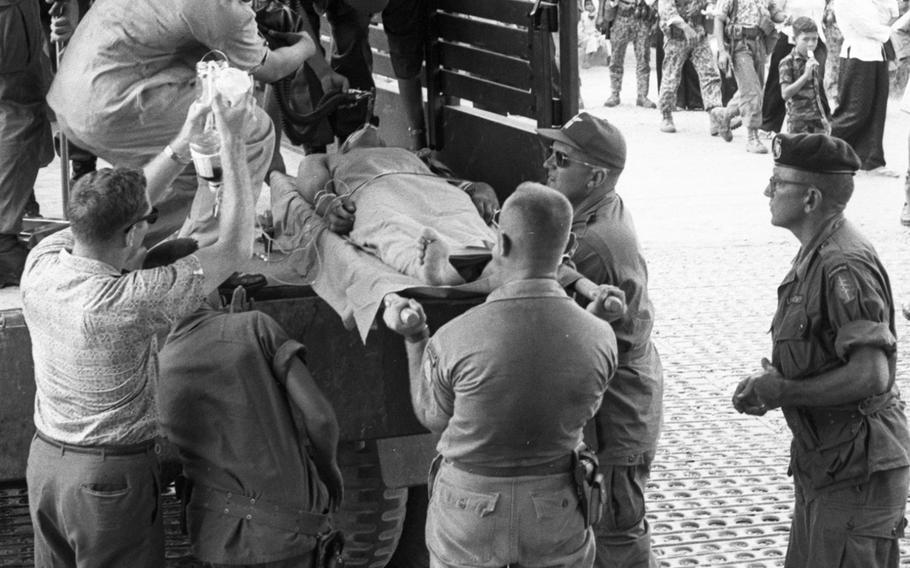
A badly-wounded U.S. Special Forces sergeant is moved from a small field hospital to Saigon in 1965. (Mike Mealey/Stars and Stripes)
TAY NINH, Republic of Vietnam — The young Army doctor put his stethoscope on the form before him for perhaps the 10th time, listened closely to the faint pulse, then stood erect and shook his head.
"I don't think he has a chance, but the only way we'll ever save him is to get him to Saigon. He might not even survive the trip, but he'll die for sure unless we get him out of here."
The patient — an American Special Forces sergeant and father of two children — had already beaten the odds; it had been 90 minutes now since the Viet Cong bullet tore through his head.
He had been on a mercy mission, riding in the back of a truck en route to various villages in the area to deliver medical supplies. One other American, team medic SFC Arthur J. Bates, and two Vietnamese also were in the truck when the sniper's single shot was fired. Bates later recalled, "I heard him fall. I thought he was dead, but I could feel a pulse ..."
Now the wounded man lay on the operating table at a small field hospital staffed largely by a 12-member Filipino medical team. Bottles of plasma and other fluids were connected to each arm. Machinery pumped oxygen into him. The Filipino doctors and technicians checked his blood pressure again and did what they could to keep him alive.
An American doctor, Capt. Richard Wurster — who arrived in Vietnam 19 days earlier — stepped into the hallway outside the operating room and conferred with 1st Lt. John J. McGowan, a pilot with the 57th Medical Evacuation Detachment.
"Do you think we could get all the apparatus into the helicopter?"
They stepped into the operating room, then decided to try to get a C-123. McGowan headed back to the chopper, got on the radio, and in minutes a fixed wing aircraft was diverted from another mission to make the evacuation.
There was nothing to do then but wait. Wurster paced, occasionally stopping to check the victim's blood pressure or pulse.
In a few minutes another wounded American was brought to the hospital — victim of a sniper in the same area. He had a wound in his stomach. Three Vietnamese came in behind him, also hit by enemy fire.
Wurster prepared the second American for evacuation, and by the time he was ready, the C-123 was at the airfield a mile away, waiting for the patients.
Other Special Forces men grabbed the sergeant's stretcher while doctors carried plasma and other fluids, along with the oxygen machines.
There was a 10 minute ride on a truck — creeping along to avoid a fatal jar to the patient — then his stretcher was strapped to the deck of the plane. Doctors strained to hear a pulse beat above the roar of the plane's engines, and occasionally one doctor would look at the other and nod his head to indicate that the man was still alive.
By noon, three hours after he was wounded, the American was in an ambulance on the way to a Saigon hospital, where neurosurgeons would try to keep him alive. Wurster was still at his side, commenting that the victim's chances weren't much better than they were before, but at least now doctors could try to stop the bleeding and give him the best possible chance at life.
That afternoon the patient died, despite the valiant efforts to save him.
The odds had been great, but the doctors tried.
You don't think about odds when you try to save a man's life; the man wasn't thinking about the odds of getting killed, when he left camp that morning to help others.